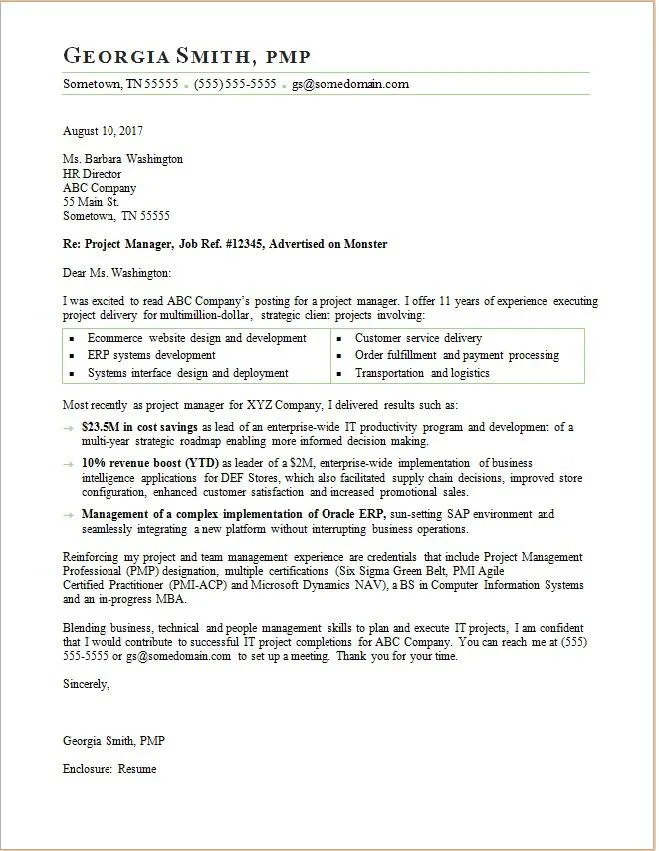Crafting a Compelling Project Manager Cover Letter
A well-crafted project manager cover letter is your opportunity to make a strong first impression and distinguish yourself from other candidates. It’s not just a formality; it’s a strategic tool to showcase your skills, experience, and enthusiasm for the role. Your cover letter should complement your resume, providing a narrative that highlights your qualifications and demonstrates your understanding of the specific job requirements. It should be concise, focused, and tailored to each position you apply for, making it clear why you are the ideal candidate. By following the right approach, you can significantly increase your chances of landing an interview and ultimately securing your desired project management position.
Understanding the Purpose of a Cover Letter
The primary purpose of a project manager cover letter is to introduce yourself and your qualifications to a potential employer. It serves as a preview of your resume, expanding on key aspects of your experience and skills relevant to the job. It also allows you to express your interest in the specific role and company, demonstrating that you’ve done your research and understand their needs. The cover letter provides a space to highlight your unique value proposition, showcasing what sets you apart from other applicants. It’s an opportunity to personalize your application and make a connection with the hiring manager, increasing the likelihood of your application being noticed and considered.
Highlighting Relevant Skills and Experience
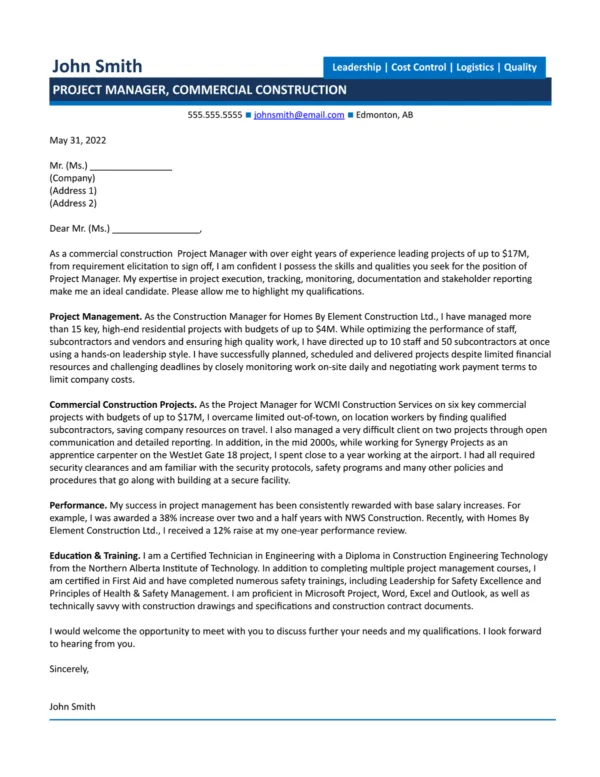
When writing your cover letter, focus on the skills and experiences most relevant to the project manager role. Project management encompasses a wide range of skills, including leadership, communication, problem-solving, risk management, and technical proficiency. Identify the core competencies emphasized in the job description and provide specific examples of how you’ve demonstrated these skills in past projects. Detail your experience with project methodologies like Agile, Scrum, or Waterfall, and quantify your accomplishments whenever possible. For instance, mention how you successfully delivered a project on time and under budget, or how you improved team efficiency by a certain percentage. Highlighting these achievements will showcase your capabilities and make a compelling case for your candidacy.
Top 10 Tips to Impress with Your Cover Letter
Research the Company and Job
Before writing your cover letter, thoroughly research the company and the specific project management role. Understand the company’s mission, values, and recent projects. Identify the key responsibilities and required skills outlined in the job description. Tailor your cover letter to align with these specifics, demonstrating that you understand the company’s needs and can contribute to their goals. This shows your genuine interest and commitment to the opportunity, making your application stand out from generic ones. Understanding their industry and challenges is also important.
Customize Your Letter
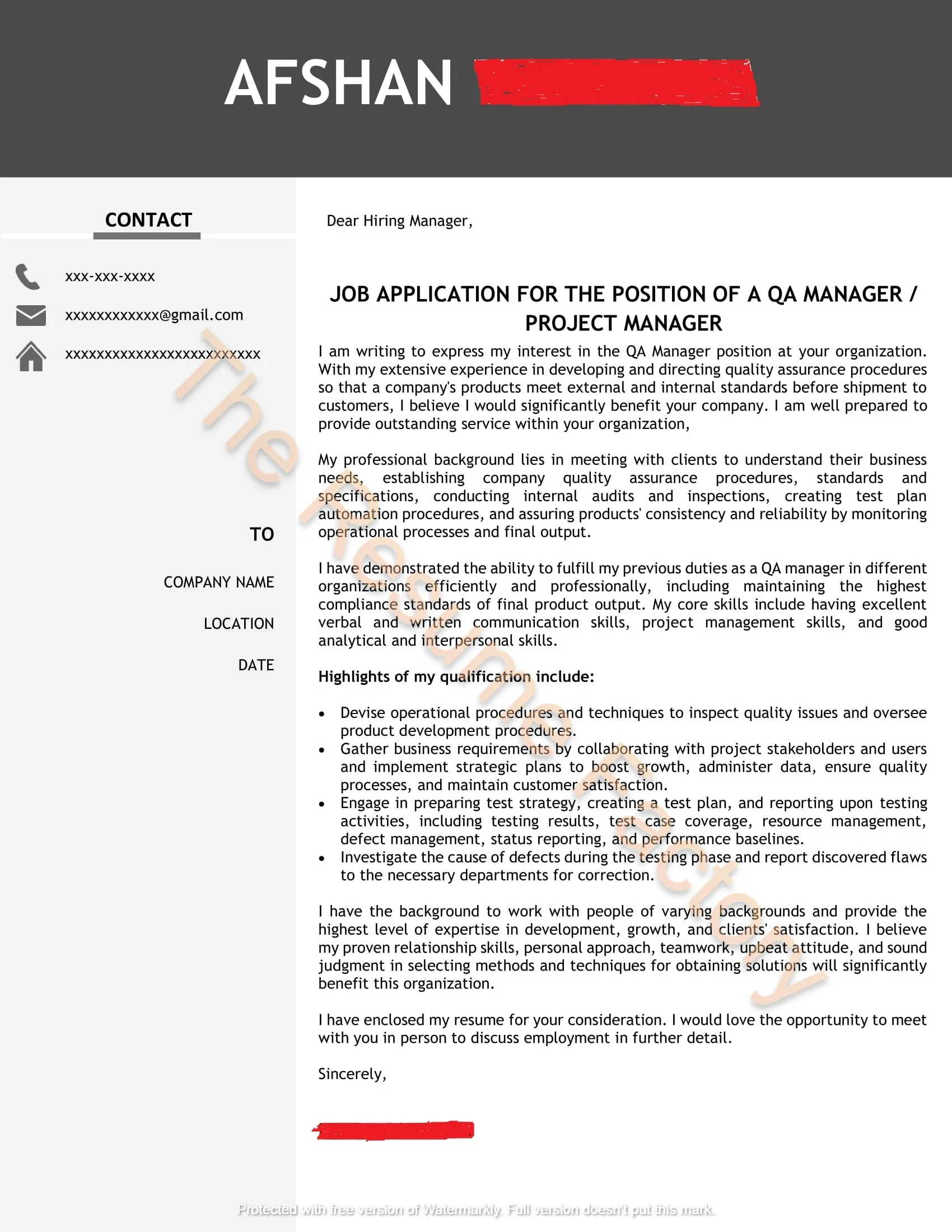
Avoid using a generic cover letter template. Customize each cover letter to match the specific job and company. This involves tailoring the language, highlighting the most relevant skills, and providing examples that demonstrate your understanding of the role’s requirements. Refer to specific projects or initiatives mentioned in the job description. This level of personalization shows that you’ve invested time and effort in your application, making it more compelling to the hiring manager. Furthermore, make sure your tone fits their culture. Use project management tools as an example of understanding their needs.
Start with a Strong Opening
Your opening paragraph is crucial for capturing the reader’s attention. Start with a compelling statement that grabs the hiring manager’s interest. You could mention a significant achievement, express your enthusiasm for the role, or reference a mutual connection. Avoid generic opening lines like “I am writing to express my interest…” Instead, aim to be concise, confident, and directly address the company’s needs. This sets a positive tone and encourages the reader to continue reading, making them want to know more about what you can bring to the table. Use strong verbs and highlight your main value proposition.
Showcase Your Achievements
Instead of just listing your responsibilities, showcase your achievements. Use the STAR method (Situation, Task, Action, Result) to describe your accomplishments in previous projects. Briefly outline the situation, the task you were assigned, the actions you took, and the positive results you achieved. Quantify your achievements whenever possible to demonstrate the impact of your work. For instance, “Managed a team of 10 to deliver a project 15% under budget and two weeks ahead of schedule.” Highlighting your successes makes a stronger case for your capabilities than simply stating your job duties.
Quantify Your Accomplishments
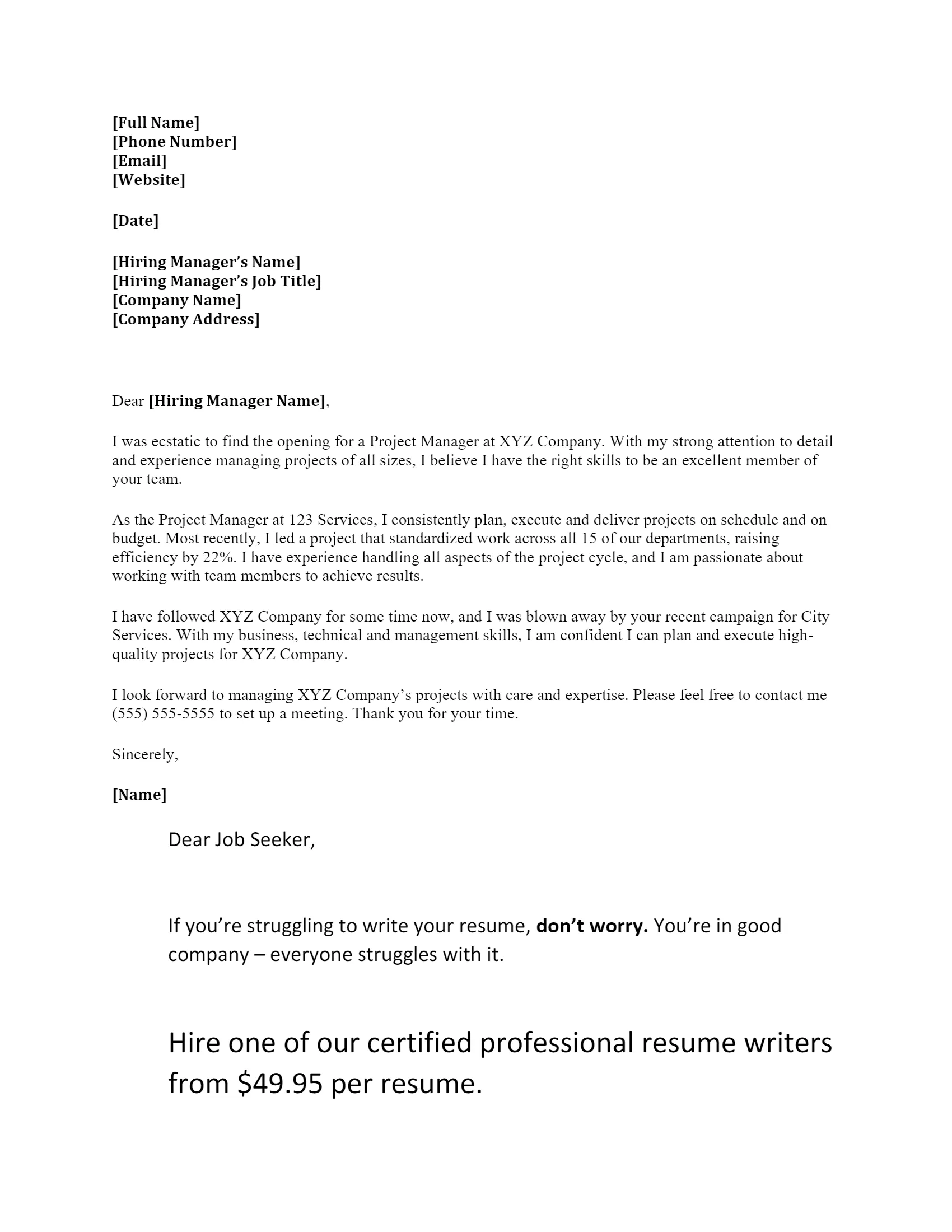
Whenever possible, quantify your accomplishments to make them more impactful. Use numbers, percentages, and specific data points to demonstrate the tangible results of your work. For example, instead of saying “Improved project efficiency,” say “Improved project efficiency by 20% through the implementation of Agile methodologies.” Quantifiable achievements provide concrete evidence of your skills and abilities, making your cover letter more persuasive. Quantifying your accomplishments gives the hiring manager a clear understanding of the value you can bring to their organization. Using metrics related to time, budget, and team performance is highly effective.
Focus on Relevant Keywords
Carefully review the job description and identify the key skills and keywords the employer is seeking. Incorporate these keywords naturally throughout your cover letter. This not only helps your application get past applicant tracking systems (ATS) but also demonstrates that you possess the specific skills and experience the employer requires. Ensure that the keywords are relevant to your experience and are used within the context of your achievements and skills. Be authentic, and don’t stuff keywords in your letter. Your goal is to show a perfect match for what the hiring manager is looking for.
Demonstrate Your Understanding of the Role
Show the hiring manager that you understand the specific responsibilities and challenges associated with the project management role. Briefly discuss your experience with relevant project management methodologies, tools, and techniques. Mention how you have handled common project management issues, such as scope creep, budget constraints, and team conflicts. Demonstrate your knowledge of the industry and the company’s specific needs. Highlighting your problem-solving abilities and strategic thinking demonstrates your suitability for the position, showcasing you are ready to tackle any challenges.
Proofread Meticulously
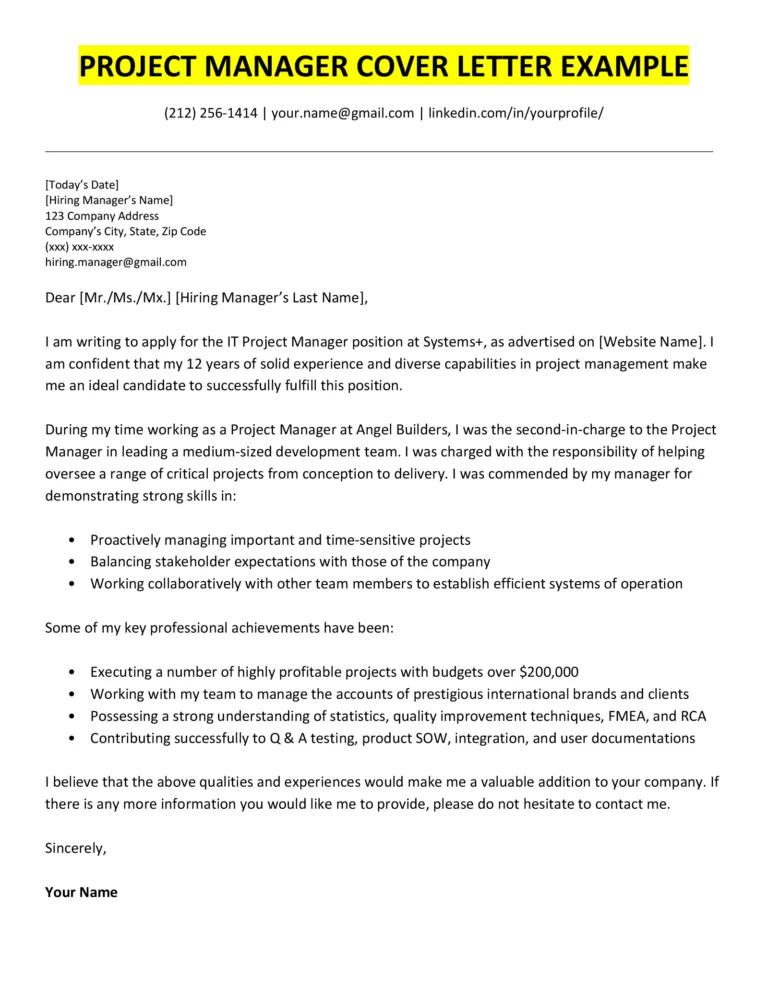
Proofread your cover letter carefully for any typos, grammatical errors, or inconsistencies. Errors can undermine your credibility and create a negative impression. Use spell-check and grammar-check tools, but also read through your letter multiple times to catch any mistakes that automated tools might miss. Consider having a friend or colleague review your cover letter for feedback. A polished and error-free cover letter demonstrates attention to detail and professionalism, which are crucial for a project manager. A mistake-free letter is a sign of your dedication and commitment to the role.
Use a Professional Tone
Maintain a professional and respectful tone throughout your cover letter. Use formal language and avoid slang, jargon, or overly casual expressions. Show enthusiasm for the role while remaining objective and concise. Address the hiring manager by name whenever possible, and use a professional closing. Make sure your tone aligns with the company’s culture. A professional tone demonstrates your understanding of workplace etiquette and your commitment to your career. Project managers are often the face of the company, so projecting a polished image is key.
Format Your Letter Clearly
Use a clear and easy-to-read format for your cover letter. Choose a professional font like Times New Roman, Arial, or Calibri, and use a font size between 10 and 12 points. Keep your paragraphs short and concise, and use bullet points to highlight key skills and accomplishments. Ensure consistent spacing and margins for a clean and organized look. A well-formatted cover letter is easier to read and allows the hiring manager to quickly grasp the essential information. Make sure it is easy to scan, with clear headings and a logical flow. This visual clarity enhances the overall impact of your letter.
Include a Call to Action
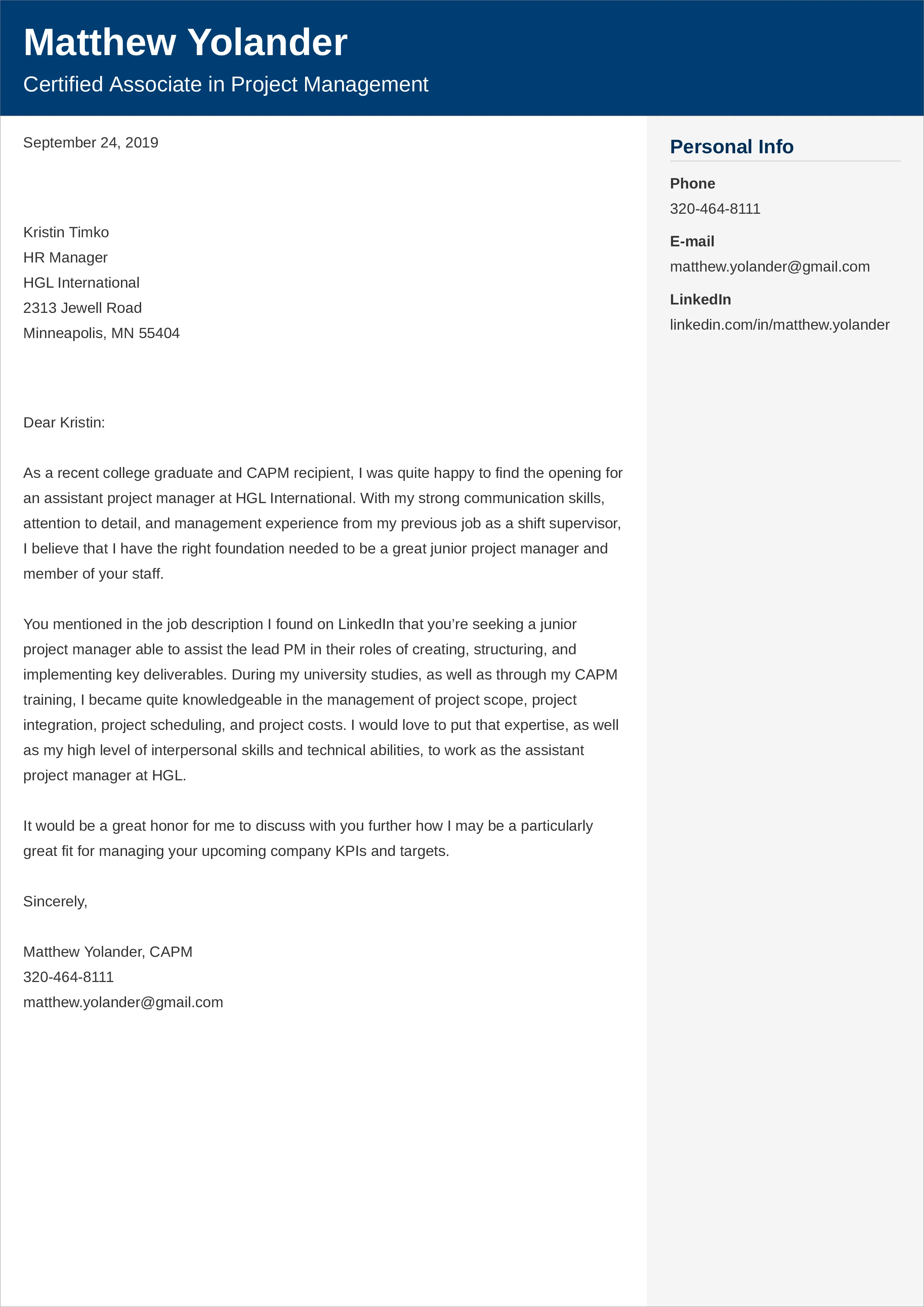
End your cover letter with a clear call to action. Express your eagerness to discuss your qualifications further and thank the hiring manager for their time and consideration. Provide your contact information and indicate your availability for an interview. A call to action encourages the hiring manager to take the next step in the hiring process. Make it easy for them to contact you. This demonstrates your proactive approach and your commitment to securing the project management position. Make sure to reiterate your enthusiasm and highlight your availability.
Key Elements to Include in Your Cover Letter
Contact Information
At the top of your cover letter, include your full name, address, phone number, and email address. Ensure your contact information is up-to-date and professional. Also, include the date. This makes it easy for the hiring manager to contact you promptly and helps organize the information. Ensure that your email address is appropriate and professional. The information should be clearly presented, allowing the hiring manager to easily find your contact details. This information is the first thing the hiring manager will see.
Professional Summary
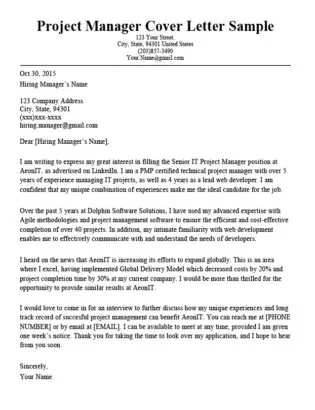
Include a brief professional summary at the beginning of your cover letter. This section should highlight your key skills and experience in project management. Briefly state your years of experience, your areas of expertise, and your most significant achievements. The professional summary should be tailored to match the requirements of the job description. This gives the hiring manager a quick overview of your qualifications and helps them understand why you’re a good fit for the role. This helps the hiring manager quickly identify the value you bring to the role.
Key Skills and Competencies
Highlight your key skills and competencies relevant to project management. This should include both technical and soft skills. Examples include project planning, risk management, budget management, communication, leadership, and problem-solving. Provide specific examples of how you have used these skills in past projects. Tailor this section to align with the skills mentioned in the job description. This allows the hiring manager to quickly assess your capabilities and understand how you meet the job requirements. Highlighting the key skills demonstrates your preparedness to handle the project management requirements.
Project Management Experience
Provide detailed information about your project management experience. List your previous roles and the projects you managed. For each project, include the project’s scope, your responsibilities, and the results you achieved. Quantify your accomplishments whenever possible. Highlight your experience with various project management methodologies such as Agile, Scrum, or Waterfall. This gives the hiring manager a clear understanding of your project management capabilities and how you’ve applied your skills. Demonstrating your project management experience gives credibility to your application.
Education and Certifications
List your educational qualifications and any relevant certifications. Include the name of your degree, the name of the institution, and the dates of attendance. Highlight project management certifications like PMP, PRINCE2, or CAPM. If you have any specialized training related to project management, include it here. This confirms your formal qualifications and professional development in the field of project management. Provide clear details on your credentials to make your expertise verifiable.
Tailoring Your Cover Letter to Different Industries
IT Project Management
For IT project management roles, emphasize your experience with software development, system implementations, and IT infrastructure projects. Highlight your knowledge of Agile and other relevant methodologies. Include specific examples of successful technology projects you have managed. Demonstrate your ability to manage IT projects from start to finish. Highlighting industry-specific knowledge will enhance your application, showing that you understand the industry’s needs. Demonstrate a working knowledge of relevant technologies, and tools.
Construction Project Management
For construction project management roles, highlight your experience with construction projects, managing budgets, schedules, and subcontractors. Emphasize your knowledge of construction codes, regulations, and safety standards. Provide specific examples of successfully completed construction projects. Demonstrate your ability to handle project challenges in the construction sector. Highlight your ability to navigate complex construction projects. Include relevant certifications related to the construction industry.
Healthcare Project Management
When applying for healthcare project management roles, highlight your experience with healthcare projects, such as implementing new systems, managing healthcare facilities, or improving patient care processes. Demonstrate your knowledge of healthcare regulations and patient privacy standards. Show your experience working in a healthcare environment. Demonstrate that you understand the unique demands of healthcare projects. Highlight your expertise in managing healthcare projects and understanding industry-specific challenges.
Tips for Formatting Your Cover Letter
Choosing the Right Font and Font Size
Choose a professional font like Times New Roman, Arial, or Calibri. Use a font size between 10 and 12 points. This ensures that your cover letter is easy to read and visually appealing. Use a standard font size and style to project professionalism. Ensure the chosen font is clear and legible, helping the hiring manager easily read your content.
Using Proper Spacing and Margins
Use consistent spacing and margins throughout your cover letter. Maintain 1-inch margins on all sides of the page. Use single or 1.15 line spacing for the body of your letter. This makes your cover letter look neat and organized, improving its readability. Proper spacing and margins ensure your letter is visually appealing and makes it easy to scan the content. The formatting helps the hiring manager quickly grasp the main points.
Structuring Your Cover Letter for Readability
Structure your cover letter with clear headings and paragraphs. Use bullet points to highlight key skills and achievements. Keep your paragraphs concise and to the point. A well-structured cover letter is easier to read and helps the hiring manager quickly understand your qualifications. Organizing your content with headings and bullet points makes it easier to scan and grasp key information. This increases the chances of your application being noticed.
Common Mistakes to Avoid
Generic Cover Letters
Avoid sending generic cover letters. Customize your letter to each job and company, highlighting your relevant skills and experience. Tailoring the letter shows that you have taken the time to understand the requirements of the specific role and are genuinely interested in the opportunity. A generic cover letter often does not demonstrate a genuine interest in the specific job, and this can harm your chances of getting selected. Make sure to tailor your letter to the job description.
Typos and Grammatical Errors
Always proofread your cover letter carefully for any typos or grammatical errors. Errors can make a negative impression and undermine your credibility. Ask a friend or colleague to review your cover letter as well. A well-written cover letter free of errors demonstrates your attention to detail. Ensure there are no spelling, grammar, or formatting mistakes to maintain professionalism.
Exceeding the Recommended Length
Keep your cover letter concise and to the point, ideally within one page. Avoid including irrelevant information or overly lengthy descriptions. A concise cover letter allows the hiring manager to quickly grasp your key qualifications. Respect the hiring manager’s time by being succinct. Focus on the most relevant information and avoid unnecessary details.
Conclusion
A well-crafted project manager cover letter is a powerful tool that can significantly increase your chances of landing your desired job. By following the tips outlined above, you can create a cover letter that showcases your skills, experience, and enthusiasm for the role. Remember to tailor your cover letter to each job, highlight your achievements, and proofread carefully. Good luck with your job search!
